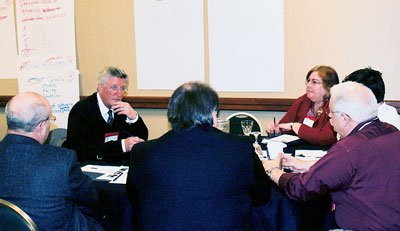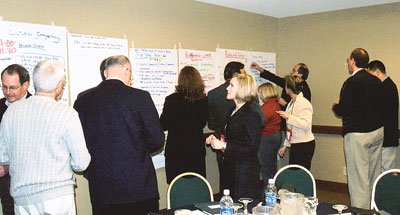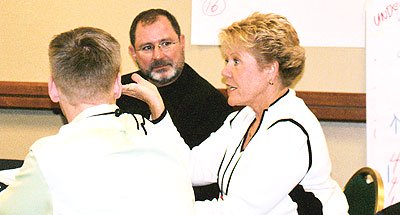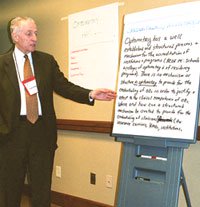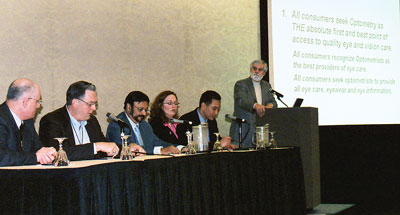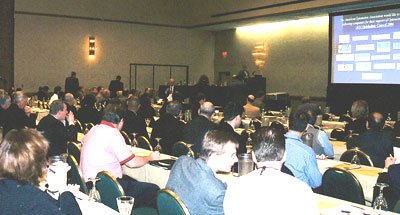Second Optometry 2020 Summit explores ‘the preferred future’
DALLAS — In the second of three Optometry 2020 Summits developed by the American Optometric Association, optometrists from across the country convened here to discuss the “desired state” of the profession in years to come.
The attendees were divided into eight discussion groups addressing individual areas of optometry. Each group was given the task of developing six “end-state goals” pertaining to their assigned topic.
“We look at all social, demographic and political forces that might be affecting us in 2020,” said Joan Henke-Tilton, MS, facilitator of the Knowledge, Education and Training group. “What is that ‘ideal state’? What does it look like? It needs to be descriptive, and it needs to be exciting and motivational.”
After the breakout sessions, the groups presented their tentative findings on each topic.
Eye Care Patient/Consumer
The group designated to discuss the desired state for the category of Eye Care Patient/Consumer delineated their objectives for optometry’s future in this area.
The first desired state is that “all consumers seek optometry as the absolute first and best point of access to quality vision care,” according to the group’s conclusions.
Facilitated by Cody Clark, the group also expressed the need for increased awareness by the public, health care workers and other professionals of the roles of vision and its potential for treatment.
The ability for all consumers to have access to optometric care without restriction was another important goal touched upon. The group discussed the current obstacles to this access, including limited financial resources, underinformed patients and professionals, limited personal time, geographical and transportation limitations, and cultural differences.
The group proposed that more complete access to quality eye care could be accomplished through the following steps:
- universal insurance coverage
- national and international mobility of licensure
- “as-taught” legislation
The session also concluded that there will be a need for “one-stop shopping” in which a patient’s medical and consumer needs will be addressed in one setting.
|
|
|
|
|
|
Knowledge, Education and Training
This group, facilitated by Ms. Henke-Tilton, focused on the ways in which optometric education could be improved upon and made more readily available.
The group discussed the alleviation of student debt, with a goal of allowing for the vast majority of optometry students to graduate debt-free.
Another goal defined by the group was the development of an “as-taught” approach to optometry, in which real-life optometric practice would reflect what was taught in optometry school.
The as-taught objective aims to establish optometry as an autonomous profession with seamless education and continued assessment of competence.
Ongoing optometric training was addressed in the discussion as well. This need would be met through the availability of an accredited optometric virtual knowledge training center. This center would enable optometrists to obtain and maintain education, competence and licensure within the profession.
The need for a transition into and retirement from the profession of optometry was also stressed in the discussion, as was the necessity of sufficient funding and resources for optometric education.
Licensure, Regulation and Continuing and Advanced Competency
|
|
Facilitated by Jeff Waldo, MS, this group aspired to a situation in which optometry demonstrates continuing core competence and advance competence in specialized areas, through a universally recognized method.
“Canadian groups have a peer system where different doctors provide mentoring programs,” said group member Jeff Gonnason, OD. “These programs are available if you need help to get you back up to speed.”
Another desired state specified by the group includes optometry being recognized as the professional authority that defines guidelines and policies for all eye and vision issues and health care.
“We are currently not the recognized authority,” Dr. Gonnason said. “If we restrict ourselves to the policies we work under, we will restrict our profession.”
The issue of continuing competence and credentialing of all optometric practitioners was another area of emphasis for the year 2020.
“There is a need for the body of optometry to develop a structure and process for the periodic credentialing of all optometric practitioners,” said group member N. Alden Haffner, OD, PhD. “This process should speak to the issue of continuing competence.”
The accrediting of institutions, programs and office/clinic/hospital-based optometric practices through a universally recognized process was another goal cited by this discussion group.
Industry and Professional Synergies
Facilitated by Codie Wilson, the Industry and Professional Synergies group concentrated on the further development of a beneficial relationship between the optometric profession and industry.
The desired state described in this discussion would be one in which “the profession and industry collaborate in full partnership to enhance services, develop new technologies and provide innovative therapies for the benefit of the consumer,” according to the presentation made by this group.
In this desired state, all optometrists will deliver the highest quality of patient care through the use of the best available eye care products and technology, with no restrictions on physical location, affordability or scope of practice.
The group also expressed a need for integrated communications with “single portal access” for professional functions via electronic medical records.
In this desired future, optometry and industry would be unified through a partnership with the American Optometric Association. The AOA, with 90% membership, will work with industry to meet the needs of all optometrists in every mode of practice.
Research resulting from the partnering of optometry and industry will reflect optometry’s intellectual leadership in developing optical, medical, functional and technological advances, according to this group’s presentation.
Science and Technology
The group charged with discussing science and technology envisioned a future in which technology is fully used to educate the public regarding eye health.
Educating optometrists was also discussed as a priority by this group, which was facilitated by Natasha Vita-More, MS.
“Most practicing optometrists resist change,” Ms. Vita-More said. “All generations of optometrists must be educated about the importance of technology through different approaches.”
In the desired state, optometry will have unrestricted access to use and contribute to all health records and technologies.
In addition, optometric research and the application of technology such as molecular biology, artificial intelligence, nanotechnology and molecular manufacturing will drive the management strategies in eye care, according to this group’s presentation.
The education of the optometric community will be constantly evolving and convenient and will include virtual classrooms, artificial intelligence-driven technologies and on-demand “smart” reference libraries, which are available via multiple modalities.
New technologies will also enable optometrists to focus more on the medical treatment aspects of the profession. “Technological changes in eye care delivery systems will allow optometry to focus more on diagnosing and treating ocular and systemic conditions/diseases,” the group’s presentation stated.
In this desired state, optometry will fully incorporate genomics, the group concluded.
|
|
|
|
Economics
The Economics group discussed the priorities for building a prosperous future for the profession.
Facilitated by Tom Hoffmann, the group envisioned a desired state in which most established practices will be successfully transitioned to another optometrist, thereby preserving economic viability of existing practices.
Another important goal established by this group is the participation of optometrists in a third-party plan of their choice, without discrimination regarding reimbursement or access.
“The economic result is the introduction of new patients to optometric services and retention of existing patients while ensuring appropriate compensation,” the group’s presentation stated.
As did many of the other breakout sessions, this group stressed the need for an as-taught scope of practice, which in an economic sense will allow optometrists to provide the public with the most cost-effective access to advanced eye care.
Increased inter- and intraprofessional referrals were also described as being part of optometry’s desired economic state. Universal licensure and universal scope of practice were cited as important aspects of the future.
A stronger, more organized optometric association was also discussed as a means of promoting and protecting the patient’s best interest and the ability of optometrists to render comprehensive health care services to the public.
Eye Care Delivery
Facilitated by Keith Orndoff, the group assigned to discuss eye care delivery looked at several facets of this topic as they pertain to optometry’s future.
In optometry’s desired state, eye care delivery will be enhanced by nationwide, uniform, self-regulated licensure with an available residency program in optometric surgery, according to the group’s statement.
Installing optometrists in prominent state and national leadership positions was also cited as a benefit to the future of eye care delivery. The group also agreed that eye care delivery is enhanced by increased membership and participation in organized optometry.
According to the group’s conclusions, eye care delivery will be improved through consumer-driven health care with unrestricted access and parity.
“Eye care delivery will be enhanced by a consumer-driven awareness of functional, developmental and rehabilitative services provided by optometrists, while increasing the medical model of eye care,” the group’s conclusion stated.
Human Resources
Facilitated by Catherine Cosgrove, LLB, this group discussed the intricacies of operating an effective optometry practice with a team of ancillary personnel.
“Things will change, and we need to be positioned to change our human resources accordingly,” she said.
The goals defined by this group were broken down into categories of training, delegating, retaining, teaming, serving and recordkeeping.
In the area of training, it was emphasized that, in an ideal future, optometrists will have access to uniformly trained and qualified staff. This will be accomplished partly through a national standard for a Web-based core curriculum and testing process for certification of an ophthalmic physician assistant. This curriculum would address many levels of education and competency, according to the group’s findings.
In terms of delegating, optometrists in the future will appropriately delegate tasks to maximize the efficiency of their offices. Another aim for optometry is to foster and enhance excellent long-term working relationships with their staff and to encourage dependability. This goal is to be achieved by recognizing and rewarding achievements by staff members.
The group also discussed the importance of teaming with other health care providers to train staff and educate patients.
The third summit will convene in Dallas, Aug. 10 to 12.
For more information:
- The American Optometric Association can be reached at 243 North Lindbergh Blvd., St. Louis, MO 63141; (314) 991-4100; (800) 365-2219; fax: (314) 991-4101; Web site: www.aoa.org. Co-chairs of the Optometry’s Summit Project Team are AOA Vice President Kevin L. Alexander, OD, PhD, who can be reached at KLAlexander@aoa.org, and AOA President-Elect C. Thomas Crooks III, OD, who can be reached at CTCrooks@aoa.org. Project Team staff members are Bridget T. Kowalczyk, MA, who can be reached at BTKowalczyk@aoa.org, and Jeffrey L. Weaver, OD, who can be reached at JLWeaver@aoa.org.

